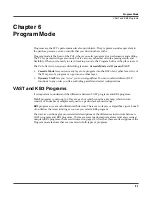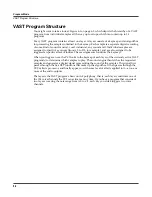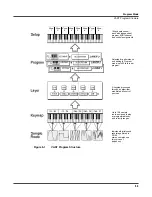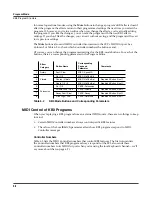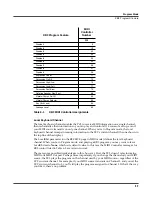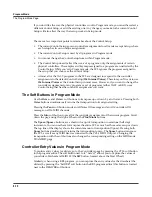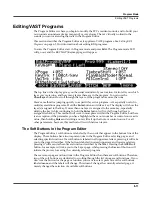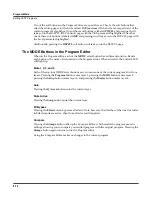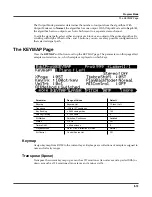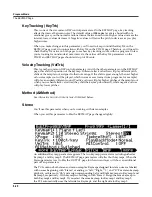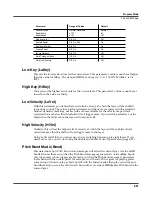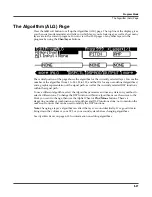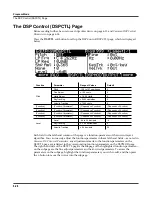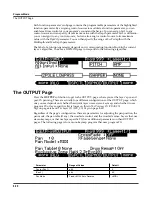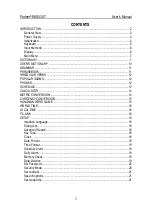
Program Mode
Algorithm Basics
6-15
By adjusting the function-parameter, you can add a fixed amount of adjustment to any DSP
function. For the Pitch function, adjusting the function-parameter will change the pitch in
semitone increments. Use this as a starting point to set the pitch where you want it to be
normally.
This will shift the pitch of the currently selected layer
, and will affect the playback rate of
sampled sounds. Sampled sounds have an upper limit on pitch adjustment. It’s normal for the
pitches of sampled sounds to “pin” (stop getting higher) when you adjust the pitch upward in
large amounts. The oscillator waveforms can be pitched higher. Any sound can be pitched
downward without limit.
The primary use of adjusting the function-parameter or fine adjust parameter (which will be
explained under the next heading) is to offset the cumulative effects of the other DSP function
parameters. For example, you might set a high value for key tracking (defined below) for a
dramatic change in effect across the keyboard. The effect might be too much at one end of the
keyboard, however, so you could use one of the adjust parameters to reduce the initial amount
of that effect.
The PC3 always uses real values of measurement, rather than just arbitrary numbers, for
adjustable parameters. This means that you specify pitch in semitones (ST) and cents (ct), and
amplitude in decibels (dB).
Remember that the parameters on the control-input pages are cumulative—they can add to or
subtract from the effects of the other parameters on the page, depending on their values. For
example, even if you’ve adjusted the pitch of a sample so high that it pins, the effects of the other
parameters may bring the pitch back down to a workable range.
Only the function-parameters can be modulated by a control source.
Fine Adjust Parameter
You can add slight detuning to the pitch with the fine adjust parameters. Notice that there are
actually two fine adjust parameters for the Pitch function: one that changes the pitch in cents
(100ths of a semitone), and one that changes it according to its frequency (in increments of
Hertz—cycles per second). Since we’re discussing the universal control sources here, and not
specifically pitch, we’ll move on for now, as the Hz parameter applies only to pitch-related
functions. See
The PITCH Page on page 6-26
for a more thorough description of Hz.
Hard-wired Parameters
Key Tracking
This is a quick way to get additional control based on the MIDI note number of each note you
trigger. Key tracking applies a different control signal value for each note number. In the case of
pitch, key tracking enables you to change the tuning of each note relative to its normal pitch.
Middle C is the zero point. Regardless of the key tracking value, there is no effect on Middle C. If
you set a nonzero value for key tracking, the effect increases for each note above or below
Middle C. In the case of pitch, for example, say you assign a value of
5 cents per key
for the key
tracking parameter. Triggering Middle C (C 4 on the PC3) will play a normal C 4. Triggering C
#
4 will play a note 5 cents higher than C
#
4. Triggering D 4 will play a note 10 cents higher than D
4, and so on. Notes below Middle C will be tuned lower than their normal pitches. If you set a
negative value for key tracking, notes above Middle C will be tuned lower than their normal
pitches.
Keep in mind that key tracking on the PITCH page works in conjunction with the key tracking
parameter on the KEYMAP page. This is why you can set the KeyTrk parameter on the PITCH
page to
0ct/key
, and notes still increase in pitch by 100 cents/key as you go up the keyboard. It’s
because the KeyTrk parameter on the KEYMAP page is already set at
100 cents per key
.
Summary of Contents for PC3
Page 24: ...1 6 Introduction Options ...
Page 50: ...4 4 The Operating Modes Using the Modes ...
Page 174: ...7 54 Setup Mode The Utility Soft Buttons ...
Page 178: ...8 4 Quick Access Mode Making Your Own QA Banks ...
Page 204: ...9 26 Effects Mono Algorithms ...
Page 266: ...A 2 MIDI Implementation Chart ...
Page 308: ...Index x ...

